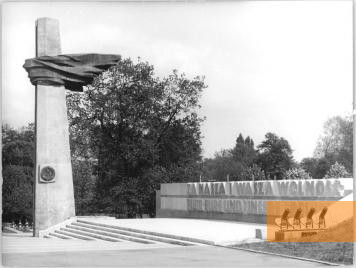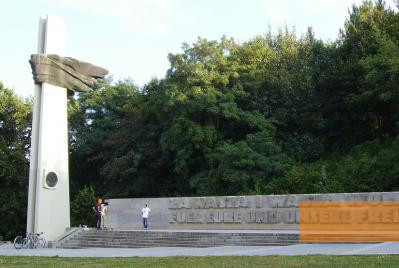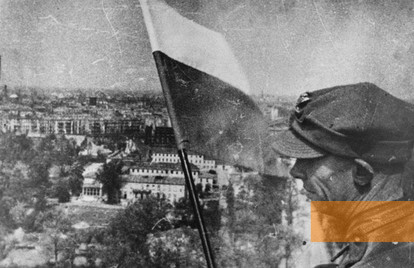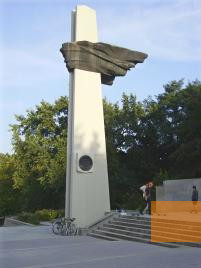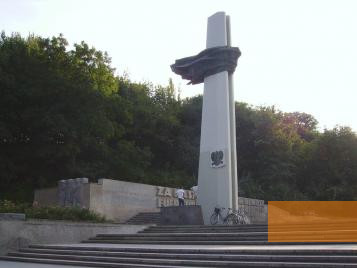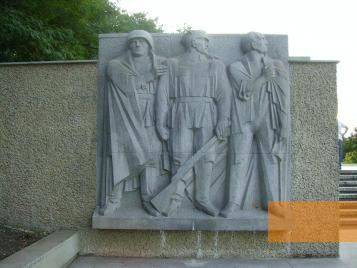The »Memorial to Polish Soldiers and German Anti-Fascists«, erected in the Volkspark Friedrichshain in 1972, honours the soldiers of the Polish communist underground army Armia Ludowa (english: People's Army) and German communist resistance fighters who stood up to National Socialism. Since 1995, the memorial has also been dedicated to non-communist resistance fighters and soldiers.
In January 1942, the communist Polish Workers' Party (Polish: Polska Partia Robotnicza, PPR) established an underground army called the People's Guard (Polish: Gwardia Ludowa) in occupied Poland. This organisation committed acts of sabotage and conducted many military operations against the German occupying regime between 1942 and 1943. At the end of 1943, the People's Guard had between 15,000 and 20,000 members. In January 1944, the People's Guard was renamed to People's Army (Polish: Armia Ludowa, AL) upon orders of the communist National Council (Polish: Krajowa Rada Narodowa). In the Summer of 1944, the AL joined forces with the Polish troops which had been assembled in the Soviet Union in 1943 under the command of Zygmunt Berling, which fought as the Polish First Army on the first Belorussian front. After these two forces had been united they were named the People's Army of Poland (Polish: Ludowe Wojsko Polskie). They took part, amongst others, in fighting in Eastern Pomerania, in the Battle of the Seelow Heights and finally in the battle for Berlin. In May 1945, the People's Army of Poland comprised of about 330,000 soldiers. It was the predecessor of the army of the People's Republic of Poland; it kept its name until 1989.
The memorial was initially dedicated to the soldiers of the Polish People's Army (Armia Ludowa) and to German communist resistance fighters against National Socialism. It was re-dedicated in 1995 and has since then also commemorated Polish and German non-communist resistance fighters, soldiers of the non-communist Home Army (Armia Krajowa), Polish soldiers who fought alongside the Allies as well as Polish forced labourers, prisoners and POWs.
The »Society of Fighters for Freedom and Democracy« (Polish: Związek Bojowników o Wolność i Demokrację, ZBoWiD) was the official, state-controlled veterans' organisation in the People's Republic of Poland. In 1965, it suggested erecting a memorial in the GDR to the Polish soldiers who fought in World War II. Contrary to initial plans, the governments of the GDR and Poland decided to dedicate the memorial to »Polish soldiers« and »German anti-Fascists« in 1967. The Polish side had requested a prominent site in East Berlin's city centre as a location for the memorial, suggesting amongst others the Pariser Platz in front of the Brandenburg gate. The GDR authorities, however, only offered the Volkspark Friedrichshain as a possible location. A German-Polish team of artists – Arnd Wittig and Zofia Wołska – jointly came up with the concept. The memorial was dedicated on May 14, 1972 in the Volkspark Friedrichshain. The memorial complex consists of three parts: a concrete column with bronze bunting, a German-Polish inscription which reads »Za naszą i waszą wolność – Für eure und unsere Freiheit« (English: »For our freedom and yours«), and a remodelled relief, which now depicts a Soviet soldier, a soldier from the Armia Ludowa and a German communist resistance fighter. During GDR times, commemorative ceremonies were regularly held at the memorial. A memorial plaque mentions the Polish People's Army's »contribution to the liberation of Europe's nations from fascism« and honours the »deeds of the German anti-Fascists«. The memorial was thus an expression of the politics of history aimed at forging a German-Polish friendship through the motif of a common fight against fascism. After German reunification, an additional plaque was affixed in 1995, honouring the non-communist Polish Home Army (Polish: Armia Krajowa) and commemorating Polish prisoners.
- Name
- Denkmal des polnischen Soldaten und des deutschen Antifaschisten
- Address
-
Virchowstraße/Margarete-Sommer-Straße
10407 Berlin - Open
- The memorial is accessible at all times


